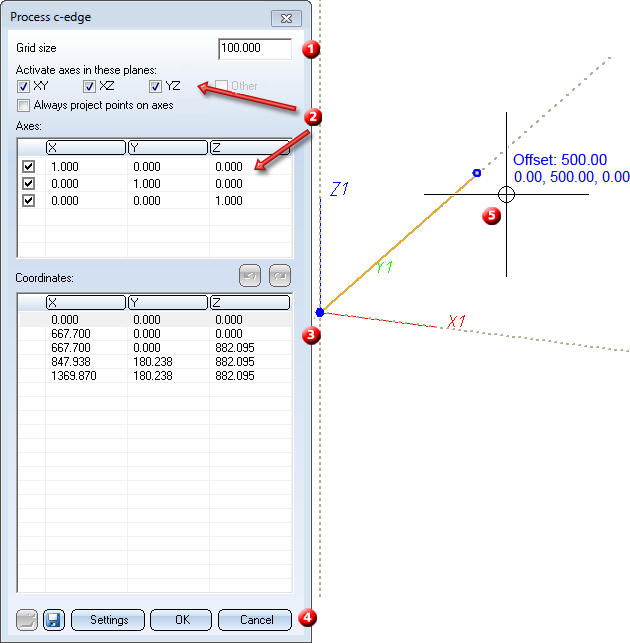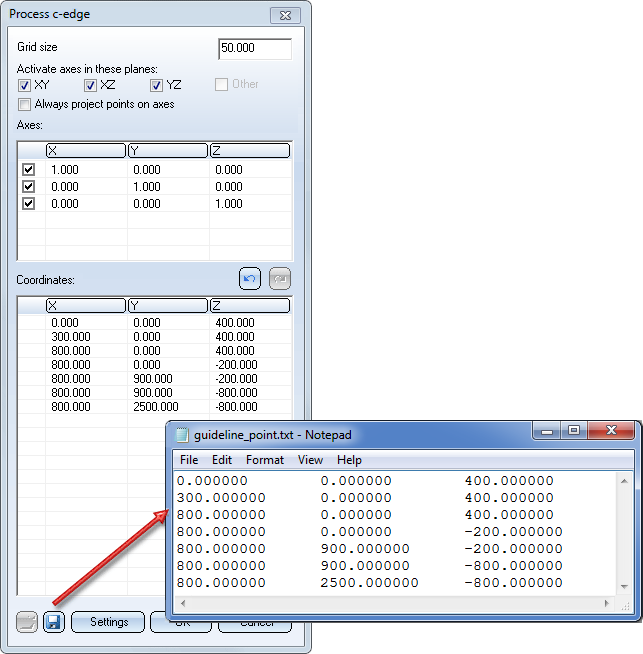Create Guideline
Plant Engineering > Guideline Tools > Create guideline 
HiCAD provides a user-friendly Guideline Editor for creating and processing of guidelines. This tool allows the determination of axes onto which points specified with the help of the graphic cursor are projected. This facilitates the construction of guidelines along previously defined directions.
The dialogue window can be divided into the following areas:
- Grid size
- Axes
You use the axes table for the determination of the axes position. By default, three axes directions are defined and activated, running parallel to the active coordinate system. In addition, you can define arbitrary, additional axes. To do this, right-click on an empty row to activate the context menu, and select Insert.
If you have defined a greater number of axes for the routing of guidelines, the identification of a particular axis may be difficult owing to the multitude of axes. In such cases, the deactivation of axes in the axes table is also rather difficult. In such cases you have the option to switch axes on or off that are located in the planes spanned by the axes of the active coordinate systems. If you want to hide axes in a particular plane, deactivate the corresponding checkbox below Activate axes in these planes:. Use the Others checkbox to hide/show axes which are not located in one of these planes.
As mentioned above, the Guideline Editor allows the determining of axes onto which points specified with the help of the graphic cursor can be projected. This method simplifies the construction of guidelines along defined directions. In older versions these projections were only possible for free points, but not for points determined via snap options, or point options such as I, J, M etc. This made a drawing of guidelines running parallel to existing structures rather difficult. An example on how this new option works can be found here.
- Coordinates
The Coordinates table displays c-edge points and allows the input of new c-edge points. The coordinates refer to the active coordinate system in the drawing (World CS or Local CS). Initially, the origin of the coordinate system is suggested as the first point. - Buttons
According to the settings in the dialogue window the display in the drawing changes as follows:
- Dashed lines indicate the position of the axes.
- At the graphic cursor (5), the distance to the previous point and the coordinates in relation to this point are shown for the position of the next point.
- Edges and points of the guideline will be shown in the colour specified in the settings.
Proceed as follows:
- Specify the grid size.
- Select the axes via activation/deactivation of the appropriate checkboxes.
- HiCAD now expects you to specify the value for the first point. You have the following input options:
Graphic cursor
- Click the left mouse button
The point is placed in the next possible position allowed by the axes position (indicated by dashed lines) and the grid size. - Snap options, for example I, J, M or via the Point options menu (e.g. M2 - Mid-point between 2 points). Snap options ignore axes and grids by default. If you do not want this, activate the Always project points on axes checkbox. An example on how this new option works can be found here.
The selected point is inserted in the drawing. In the coordinates table, the original, suggested values are overwritten by the coordinates of the point. In the next row of the coordinates table, the same coordinates are initially suggested for the next point. The function is now ready for the specification of the next point.
Coordinates table
If you double-click on an entry in the table, you can manually enter a new coordinate value. Confirm with ENTER to take over the specified value. If you now move the mouse pointer in the graphic window you will see the point for the new position in the graphic. Move the mouse pointer back to the coordinates table and place it in the empty space under the coordinate specifications. Right-click and select Insert. In the next row of the table, the same coordinates are initially suggested for the next point. The function is now ready for the specification of the next point.
- In the graphic, a line is drawn from the previous point to the position of the next possible point which is determined by the position of the cursor. You have now the same specification options as for the first point.
- Proceed likewise for all following point specifications.
- If the point specification mode is still active and you do not want to specify any further points, end the point specification with a right-click on the graphic (one more right-click would confirm the created guideline before ending the function).
The result will look as follows:
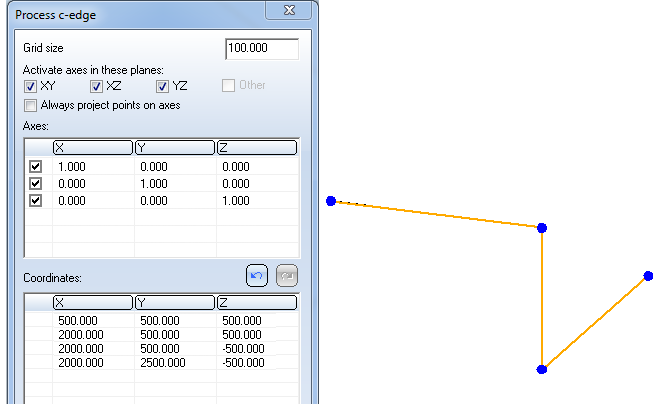
You can now process the created guideline further in many different ways. The options are the same as for the Process guideline function:
|
OK |
The guideline is confirmed and applied to the layout plan. The window is closed and the function ended. |
|
Cancel |
The guideline is rejected and deleted from the graphic. The window is closed and the function ended. |
|
Besides the colour settings for the grid, the edges and the points, you can also influence the position of the grid here. |
|
|
|
Save points list of guideline Use this button to save the points list of a guideline. In the created text file the table columns will automatically be separated by tab stops. Select the folder and the file type and enter the file name. |
|
|
Load points list Use this button to load the points of a guideline from a text file. Please note the following:
|
Trimming of guidelines
After insertion of a new guideline HiCAD will now check whether this guideline can be trimmed automatically. For this purpose it is checked whether the relevant pipeline contains a guideline on which the start point and also the end point of the new guideline is located. If this is the case, the edges that would be trimmed away will be highlighted. At the same time, an appropriate message will be displayed.
If you confirm the trimming, the already existing guideline will be trimmed and expanded by the new guideline. This means that no new guideline will be created, but only the existing guideline will be modified.
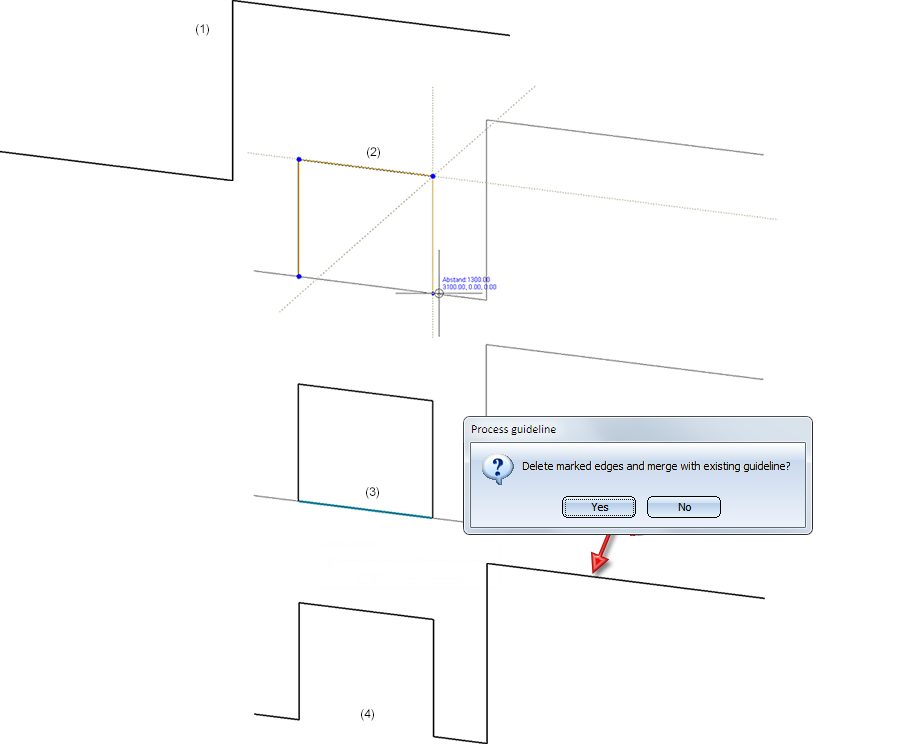
(1) Existing guideline, (2) New guideline , (3) Confirm with Yes, (4) Modified guideline
 Please note:
Please note:
- Trimming is not possible if this would remove guidelines that already contain parts.
- You can influence the grid position via the Settings.
- The direction of an axis can also be determined (besides via specification of X, Y and Z value) by identifying two points in the layout plan.
Example:
In the image below, the end points of a cuboid's lower edge are identified.
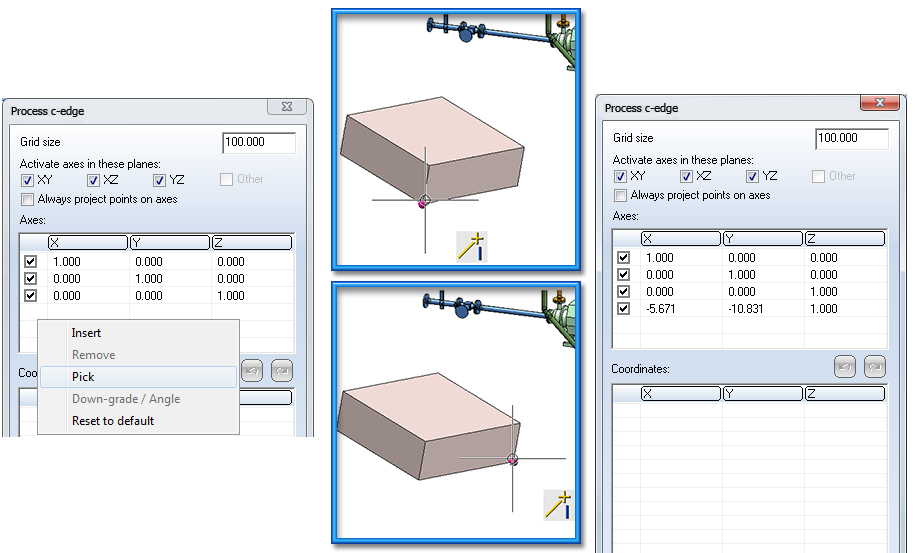
Place the mouse pointer under the last row of the axes table. Right-click to open a context menu and select Pick. Now identify the two points that are to determine the axis direction. The associated X, Y and Z-values are automatically entered into the table.

